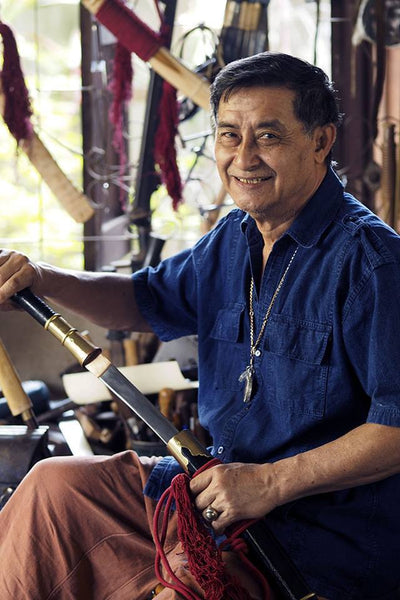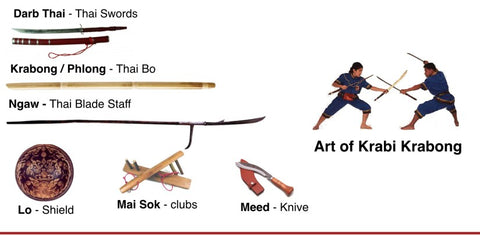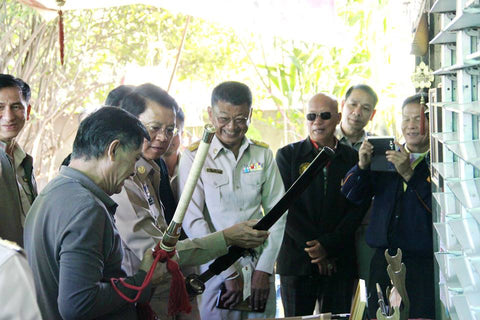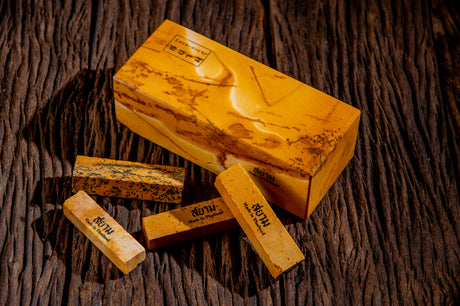For centuries, the curved Dha was the sword of choice for the warriors of southeast Asia. In a small foundry in northeast Thailand, the art of making them lives on.
- Jamie MacDonald, The Last Days of an Ancient Sword

Tucked away in a small rural village of Lampang in Northern Thailand, on a dirt road behind a humming 7/11 sign (if you can find it), is home to one of the last traditional Dhab sword makers in all of southeast Asia. Boontan Sittipaisal (Bunthun Sitthipaisan), also known as Ajarn (teacher) Kor Neeow, is one of the last ancient sword blacksmiths in southeast Asia, continuing the art of Thai Dhab sword making for a new generation of blacksmiths.

For centuries across Indochina, from Myanmar to Vietnam & beyond northern Yunnan, warriors wielded the ancient Dha, a word in Burmese for "blade" that refers to a broad range of traditional swords & knives.
Jamie Macdonald, a travel aficionado & photojournalist writes, "The horsemen in the murals of Angkor Wat had them; so did the royal guard in Hue and the legendary Kachin Rangers who fought the Japanese in the hills of Myanmar during World War II." in his article aptly named "The Last Days of an Ancient Sword"

The Burmese term dha, referred to as dhab in Thai language (daab or darb) was commonly used in Thailand by the Ayutthaya period (1350-1767 C.E.). In those ancient days, weapons were a part of daily life. Eventually swords used for warfare & practical tools were incorporated into ceremonial dances and martial arts. The ancient martial arts fighting style Krabi Krabong was birthed in Thailand out of ceremonial dance & mock fighting styles in which a flowing dual “sword and staff” was heavily featured in Traditional pastimes. 
Krabi Krabong is a traditional Thai martial art that involves the use of swords like the Dha and other weapons. The art form originated in Thailand during the Ayutthaya period (1350-1767) and has a long and rich history.
One of the most important weapons in Krabi Krabong is the dha, also known as the dhab. or Darb in Thailand. The dha is a curved, single-edged sword that is traditionally made of steel. It is used in a variety of different fighting styles, including slashing, thrusting, and parrying.
The dha is a versatile weapon that requires a high level of skill and precision to use effectively. It is an integral part of Krabi Krabong and is often used in conjunction with other weapons, such as staffs, spears, and shields.
This distinctive Thai martial art was based on various weapons systems that were formalised around 1936 as part of the Thai education system's official curriculum. Krabi Krabong often features a Dhab or Darb (Thai Sword), a Karbong or Phlong (Thai Bo), a Ngaw (Thai bladed Staff) & a Lo (Thai Shield). A Mai Sok (clubs) & Meed (Thai Knives) were also incorporated into the Thai martial art. 
The Krabi Krabong & Thai Dhab are very common cultural references in Thailand. If you've ever encountered the Royal Thai Police force long enough, you may have noticed that they use a Thai Dhab & Lo shield as their logo.

Boontan Sittipaisal, also known as Ajarn Kor Neekow, is a skilled swordsmith who specializes in the creation of dha swords, where he's even made gold swords for the Late King of Thailand. He spent many years perfecting his craft, and his swords were highly prized by martial artists and collectors alike.
Sittipaisal's dhab swords were known for their sharpness, durability, and beauty. He used a variety of traditional materials and techniques to create his swords, including forging, tempering, and grinding. He also incorporated intricate designs and patterns into the blades, making each sword unique and one-of-a-kind.
In addition to his work as a swordsmith, Sittipaisal was also an avid martial artist and a practitioner of Krabi Krabong. He trained in the use of the dha and other weapons, and was known for his expertise in swordfighting techniques.
As he continues to craft swords to this day, Sittipaisal works to preserve and promote the art of Krabi Krabong and the craft of swordsmithing in Thailand. His contributions to these ancient traditions will always be remembered, and his legacy will continue to inspire future generations.

In 1991, Boontan Sittipaisal received an award from Her Majesty, the Queen of Thailand, for his skill in sword making, an incredibly prestigious and illustrious designation that cemented Bunthun's legacy in the annals of time.

Despite the Thai Dhab's vast history depicted in artwork, movies and culture throughout Thailand, from images of the King to the intricate flowing movements of the Krabi Krabong masters, the Thai Dhab is considered to be endangered. The traditional blacksmithing methods of crafting swords in Thailand by hand are slowly fading as the older generation of craftsfolk die without having passed on their sword making skills. Ajarn Boontan Sittipaisal has made it a lifelong mission to pass his craft onto the next generation as he's trained dozens of apprentices that have combined over 200 years experience, individually as many as 20-30 years working alongside the master swordsmith.



A scabbard sheath built out of bamboo wood & rattan, wrapped in hand woven buddhist rope blessed by a local monk, holds the sword in place for those that wish to harness the bladed power. It is a functional work of beauty that transcends time. It is also a very deadly tool, built for function not merely decoration. Empires either reigned or ruined based on the skills of the ancient blacksmiths that crafted them & the warriors the wielded them into battles won long ago.

All of these painstakingly crafted Thai Dhab swords are coal forged using a traditional hand fan system utilizing imported high-carbon SK5 Japanese or Australian steel. They are all finished by hand by his team of expert artisan apprentices as featured in this amazing video:
The process of making a Thai Dhab Sword is as follows: the blacksmiths heat the iron steel in a ground clay forge. Each blacksmith hammers at the hot metal over a small anvil relentlessly, one man providing brute strength while the other's finer strokes shape the blade. Once the forging and traditional heat treat is completed, the smiths polish the blade into its finished form.

Other artisans in (Boontan) Bunthun's shop will hand carve the wooden handle and scabbard, or sheath, which is made in two halves palm tree wood that are held together by braided rattan fiber or brass bands. For the final touches, a metal worker adds the sword's habaki fittings and decorative pommel. Intricate engravings carved by hand featuring Buddhist blessings can also be adorned on the blade if owner wishes.
The quality of craftsmanship is very high and Mastersmith Bunthun's reputation so far reaching that his art has been featured in movies & media appearances for decades. While this ancient craft of blacksmithing a sword from scratch may be endangered, as long as Ajarn Kor Neeow or his apprentice's hammers strike, the tradition lives on.

Further endangering the sword making craft of Thailand, in 2020, COVID forced Khun Boontan to temporarily close shop during Thailand's emergency decree, scattering his workers abroad until they could return later in the year to continue working. Production has now resumed regular operations through Siam Blades online distribution network, for the first time offering Boontan's dhabs & meeds (knives) to a global audience.

Ajarn Boontan is one of the last craftsfolk to pass this tradition on to the next generation, offering to teach anyone willing to learn for practically free; pay less than 1 baht as a traditional Wai Khru offering to begin his teachings. His 2 main apprentices have worked for him for over combined 60 years, earning over 30,000 THB in monthly wages and a share of the shop's profits. For these artisans of Thailand, the Thai Dhab is a way of sustainable life.

Purchasing a highly coveted Thai Dhab from Siam Blades ensures fair trade & ethical practices through an established, secure network which guarantees the authenticity of these handcrafted blades. While everyone is encouraged to visit Bunthan's shop in Lampang, Siam Blades has become the official online distributor to a global audience, in hopes that we can prolong the craft of swordmaking in Thailand for generations to come. 
Rest assured that purchasing one of Mr. Boontan Sittipaisal's blades from Siam Blades supports this amazing Thai Artisan, his workers & their families, as well as keeps an ancient tradition alive.



